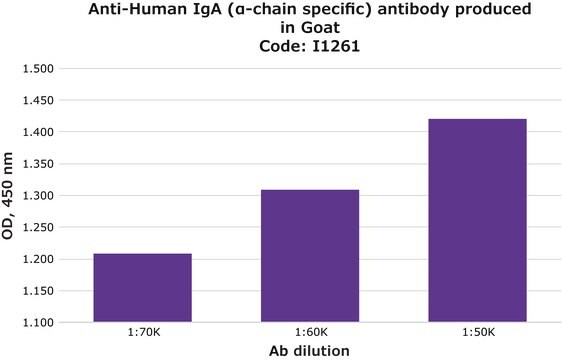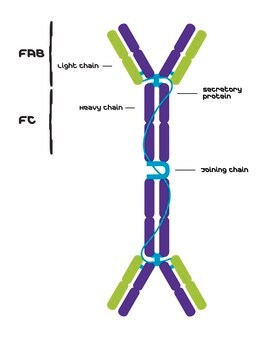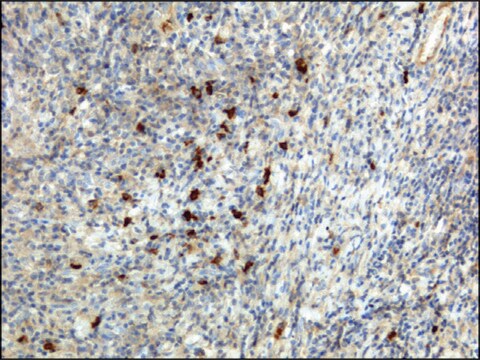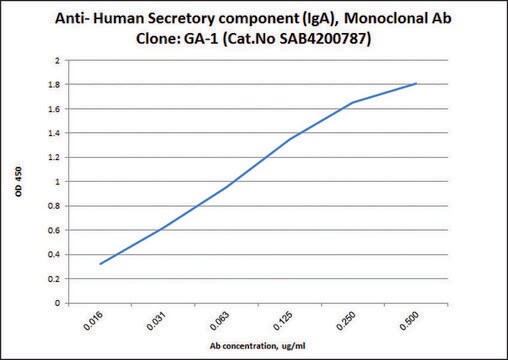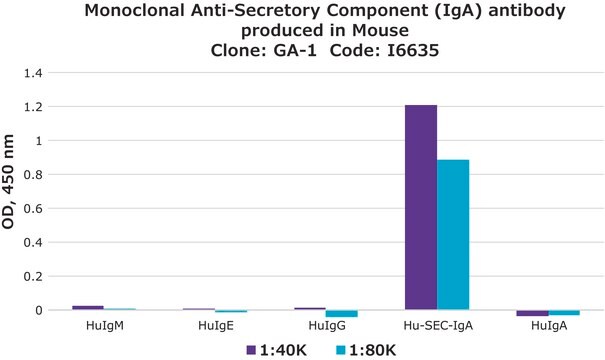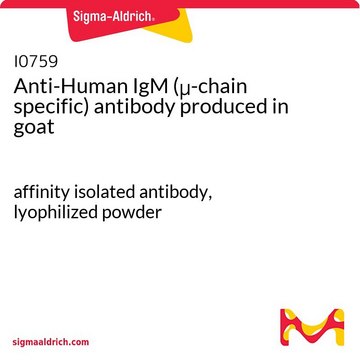I0884
Anti-Human IgA (α-chain specific) antibody produced in goat
affinity isolated antibody, lyophilized powder
Synonym(s):
Anti Human IgA Antibody - Anti-Human IgA (α-chain specific) antibody produced in goat, Anti Human Iga
Sign Into View Organizational & Contract Pricing
All Photos(1)
About This Item
Recommended Products
biological source
goat
Quality Level
conjugate
unconjugated
antibody form
affinity isolated antibody
antibody product type
secondary antibodies
clone
polyclonal
form
lyophilized powder
technique(s)
Ouchterlony double diffusion: suitable
storage temp.
2-8°C
target post-translational modification
unmodified
Looking for similar products? Visit Product Comparison Guide
General description
IgA antibody is secretory antibody and is present abundantly in mucous linings of gastrointestinal, respiratory and genitourinary tracts, tears and saliva. Thus secretory IgA contributes to the humoral defense mechanism against the pathogens on mucosal surfaces
Anti-Human IgA (α-chain specific) antibody specifically recognizes human IgA.
Anti-Human IgA (α-chain specific) antibody specifically recognizes human IgA.
Immunoglobulin A (IgA) is the primary antibody involved in mucosal immunity. It is identified by the presence of α-type heavy chains. IgA which is composed of two subclasses IgA1 and IgA2 can exist in a dimeric secretory form found in mucous secretions.
Specificity for the α-chain of human IgA is determined by Ouchterlony Double Diffusion (ODD). The antibody preparation is specific for human IgA when tested against purified human IgA, IgG, IgM, Bence Jones kappa and Bence Jones λ myeloma proteins.
Immunogen
Purified human IgA
Application
Anti-Human IgA (α-chain specific) antibody is suitable for Ouchterlony double diffusion. The antibody was used for IgA quantification by ELISA in various studies. Antibody dilution of 1:4000 was used for passive hemagglutination inhibition assay.
Goat polyclonal anti-human IgA (α-chain specific) antibody may be used to locate and identify the α-chain of human IgA by immunocytochemical and immunohistochemical (IHC) techniques.
Physical form
Lyophilized from 0.01 M sodium phosphate, 0.015 M sodium chloride, pH 7.2
Disclaimer
Unless otherwise stated in our catalog or other company documentation accompanying the product(s), our products are intended for research use only and are not to be used for any other purpose, which includes but is not limited to, unauthorized commercial uses, in vitro diagnostic uses, ex vivo or in vivo therapeutic uses or any type of consumption or application to humans or animals.
Not finding the right product?
Try our Product Selector Tool.
Storage Class Code
12 - Non Combustible Liquids
WGK
nwg
Flash Point(F)
Not applicable
Flash Point(C)
Not applicable
Personal Protective Equipment
dust mask type N95 (US), Eyeshields, Gloves
Choose from one of the most recent versions:
Already Own This Product?
Find documentation for the products that you have recently purchased in the Document Library.
Customers Also Viewed
Leif K Nielsen et al.
Transfusion, 48(9), 1892-1897 (2008-06-03)
To avoid anaphylactic reactions, immunoglobulin (Ig)A-deficient patients with anti-IgA should be transfused with IgA-deficient blood components. There is a need for fast and robust assays for demonstration of IgA deficiency and for detection of anti-IgA. Recombinant human IgA1 and IgA2
Mikael Sonesson et al.
European journal of oral sciences, 119(1), 15-20 (2011-01-20)
According to previous studies, minor glands produce about 35% of the total salivary immunoglobulin A (salivary IgA). The age-dependent increase in whole-saliva salivary IgA concentrations has been studied extensively, but we found no published reports comparing the minor-gland saliva concentrations
Hannah Andersson et al.
International journal of microbiology, 2016, 8469018-8469018 (2017-01-20)
Objective. To clarify the effect of Lactobacillus plantarum 299v on the salivary cortisol and salivary IgA levels in young adults under examination stress. Design. Forty-one students with an upcoming academic exam were included in a randomized double-blind, placebo-controlled study. The
L C Torres et al.
Brazilian journal of medical and biological research = Revista brasileira de pesquisas medicas e biologicas, 43(12), 1215-1224 (2010-11-19)
Rubinstein-Taybi syndrome (RTS) is a rare developmental disorder characterized by craniofacial dysmorphisms, broad thumbs and toes, mental and growth deficiency, and recurrent respiratory infections. RTS has been associated with CREBBP gene mutations, but EP300 gene mutations have recently been reported
P Macchiaverni et al.
Scandinavian journal of immunology, 74(6), 619-627 (2011-09-03)
There is strong evidence from animal models that placental and/or breast milk-mediated transfer of maternal allergen-specific IgG prevents allergic immune responses in the progeny. Both human and animal data also point to IgA as having an important regulatory role. In
Our team of scientists has experience in all areas of research including Life Science, Material Science, Chemical Synthesis, Chromatography, Analytical and many others.
Contact Technical Service